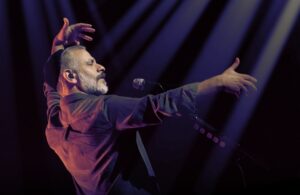The BEST: Eviatar Banai’s “Night as the Day Does Shine”

Summary: Eviatar Banai’s 2009 album Layla Ka-yom Ya’ir (“Night as the Day Does Shine”) offers a mature exploration of spirituality and the vicissitudes of an artist’s relation to his religious experience, without falling into romanticism. Banai’s lyrics reflect a sober search for the consolation of faith amid worldly temptations, the glaring void, and the continual struggle between light and shadow.
Banai began his musical career in 1997 as a secular avant-garde bohemian living in Tel Aviv. Today, Banai lives in the Jerusalem suburb of Ramot, a father of five, committed to a life of Orthodox religious observance. Banai’s transformation has not limited his career but rather deepened his artistic expression and brought him lasting commercial success.
Thanking his contemporary collaborators alongside King David, Rabbi Akiva, Ramhal, Vilna Gaon, Baal Shem Tov, Rav Kook, and the Lubavitcher Rebbe in the liner notes to this album, Banai has found a way to synthesize elements of his previous self with the new, and to bridge conflicting worlds into musical inspiration. Speaking directly to the essence of our age, Banai’s music pulls the aspiration to holiness and transcendence directly from the banal ups and downs of human experience.
Why this is The BEST: A glance through Banai’s oeuvre reveals a personal journey transformed into music. The ideal of teshuva, as it intensifies across albums, remains asymptotic; its pursuit gives direction and hope but no ultimate solution to the individual’s problems.
Since his first album in 1997, Banai has depicted the painful existence of a sensitive individual living in an intolerable world of brutality, competition, and ungratifying love entanglements: “Rough world / I can only take it by force/ only with kicks to the brain / let everything burn with a whisper / beg from me, beg from me…”
In Layla Ka-yom Ya’ir (2009), Banai continues to explore philosophical themes such as the Hobbesian world of competition, but by this time, his previous aggression is replaced by emotional maturity, and his hopelessness is counterbalanced by a newfound confidence in the prospect of a personal redemption. The album features his trademark jazz sound, but also melodies that range from 1940s Eastern European ballads (such as the song Av Ha-rahaman), to alternative Rock with a touch of New Age and world music influences.
In “Oraita,” Banai composes a personal love song to the Torah and fuses it with the words of the Zohar (“Oraita, Oraita, how shall I describe Thee”). In “Otiyot Porhot Ba-avir” (“Letters Flutter in the Air”), Banai uses an intensifying alternative rock progression to fantasize about lighting a flame of creative self-sacrifice and purification. The chorus “Diaries burn, the letters flutter in the air” evokes the Talmudic narrative of the martyrdom of Rabbi Hanina ben Teradion, who, in the moment before his death, saw that “the scrolls set alight, but the letters take flight” (Avoda Zara 18a). Unlike the destructive desire to “let everything burn” in Banai’s first single, Banai implies here that such a symbolic act may be required to reach a higher level of connection to God.
In Layla Ka-yom Ya’ir, he revisits the motif of the pit and the existential void from his previous albums; now there is a grounding counterbalance.
What a battle, mighty God, what a battle/
between the pit and the water/
At least there is a battle/
At least there is water/
Once there was only a pit.
Not selling religious connection as a panacea from the individual’s daily struggle with the existential void – “the pit” and one’s own destructive tendencies – the song focuses on the “little things,” and on having realistic expectations (“at least there is a battle” and “at least there is water”) from the religious experience. Banai’s turn to Judaism and the resulting imposition of new forms and boundaries on the experience of life have enabled him to attain new heights in his self-expression. And if life is anything like art, then what this teaches us is that the prohibitions against which we must creatively articulate our struggle – be they religious or otherwise – are what provides depth, color and intensity to our experiences.
Marina Zilbergerts is a scholar of Jewish literature and thought and the author of The Yeshiva and the Rise of Modern Hebrew Literature. Click here to read about “The BEST” and to see the index of all columns in this series.

